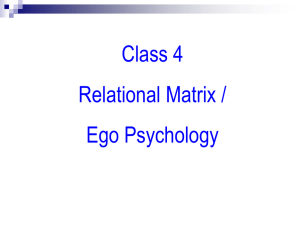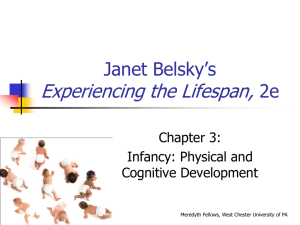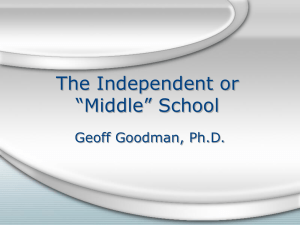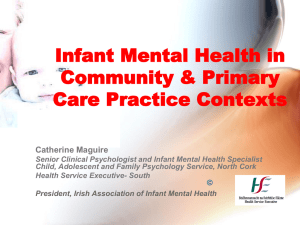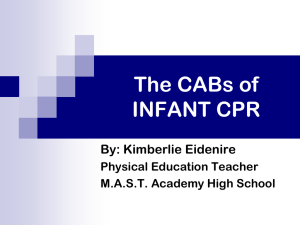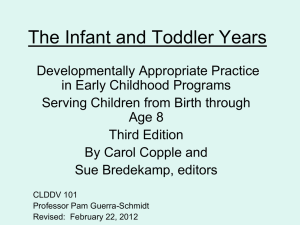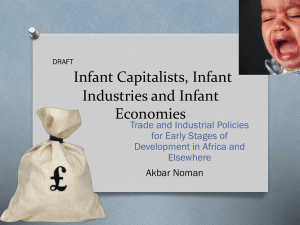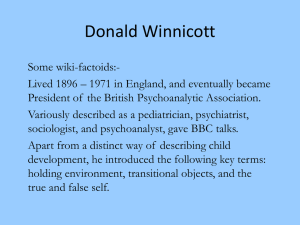good enough - Mafia Buzz
advertisement
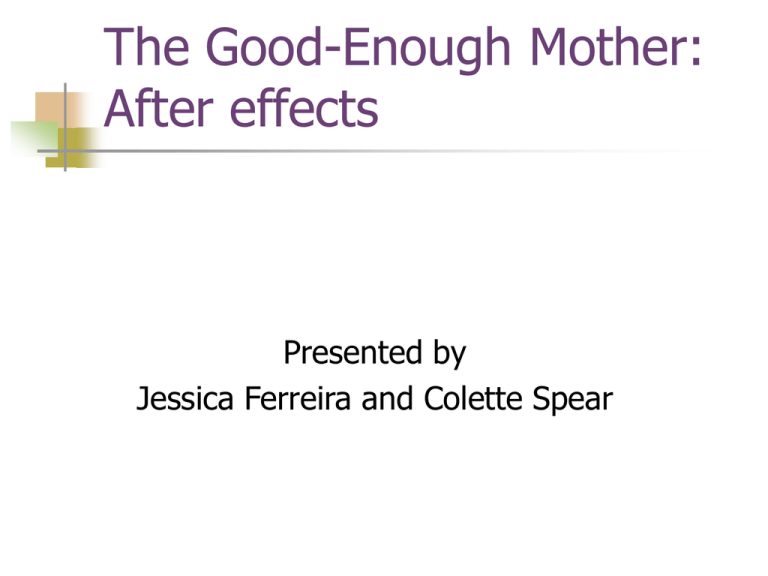
The Good-Enough Mother: After effects Presented by Jessica Ferreira and Colette Spear Overview Object Relations What is object relations theory? Freud’s views Mahler’s process of separation individuation Piaget’s object permanence Overview Cont. Donald Winnicott’s Theory Good-enough mother Holding/facilitating environment Subjective omnipotence Transitional experience and objects Objective reality True and false self After effects Optimal development Psychopathology and therapy Object Relations Theory What is Object Relations Theory? Object relations theory is a psychoanalytic approach that explains: human development, behaviour, psychopathology and relationships according to the affectionate attachments that children make in early life Object Relations Object: particular people, or the targets of children’s affection,feelings or intentions Relations: relationships and interactions that take place between children and the significant people in their lives Object Relations Internal Working Model of Attachment Relations: Conscious and unconscious rules and mental representations Guide behaviour with reference to attachment relationships and events Expectations about patterns of relationships and interactions Are able to change as the individual develops Object Relations: Freud Infant cannot discriminate between things in the environment: between person and object This creates tension within the infant and frustration of the libido or life drive The infant may experience signal anxiety (separation anxiety) when the object or mother is separated from the infant Infant’s initial attachments and internal working model of relations develop as a result of the mother gratifying the infant’s needs and drives Object Relations Freud Cont. Infant will view the mother as being good or bad, depending on whether she successfully satisfies or frustrates the infant’s needs Infant will gradually achieve a sense of object constancy Object Relations: Mahler Process of Separation Individuation: Symbiotic phase Differentiation phase Practicing phase Rapprochement phase Object constancy Object Relations: Piaget Stages of Cognitive Development: Sensorimotor stage Preoperational stage Concrete operational stage Formal operational stage Object Permanence: The awareness or recognition that a physical object is permanent and continues to exist, even when the object is no longer visible Example: Searching for a hidden toy Donald Winnicott: The Good-Enough Mother Donald Winnicott: Terms The ‘good-enough mother’ Holding (facilitating) environment Transitional experience State of maternal preoccupation Subjective omnipotence Objective reality True Self False Self Focus The mother’s role in her child’s emotional development from a dependent infant into a ‘nearly’ independent adult What makes a mother a good-enough mother? Stage 1: Subjective Omnipotence (Me) Birth… The infant is totally dependent on the mother to fulfill basic needs, e.g. food Mother responds to infant without hesitation At this stage the mother is in a ‘state of maternal preoccupation’ Baby Baby Baby Baby cries when hungry mother breast-feeds child cries when hungry mother produces object (breast) cries when hungry breast appears wishes for breast breast appears Baby believes itself to be magical : ‘subjective omnipotence’ Subjective Omnipotence Cont. The mother, or the mother’s breast = the object of the infant’s love The infant perceives the object as part of the self Self object/mother/breast The infant cannot differentiate between the mother (or breast) and the self This is a subjective phenomenon – an illusion of being-at-one with the object. Subjective Omnipotence and the Good-Enough Mother Within the context of the first stage, what is a ‘good-enough mother’? A mother who is in a state of maternal preoccupation: creates the illusion of subjective omnipotence A mother who intuitively knows when her baby is ready to move to the next stage Illusion Disillusion The good-enough mother begins to distance herself from her child in response to her child’s growing need for independence. The good-enough mother first provides the child with an illusion that a breast appears when wished for (omnipotence) Then she creates the disillusion (removal of omnipotent thinking) that progressively introduces the child into the social world as a separate being. Object Reality (Not-Me/Other-ThanMe) An awareness of the mother as an object separate from the self begins to form Self object/mother/breast The baby begins to realise: There is a world outside of the self which does not respond to a wish (the dissolution of the subjective omnipotence) The object of reality (outside world) sometimes responds negatively The good-enough mother ensures that the child feels safe without being overprotective Final Stage: ‘Near-’Independence Self objects Winnicott makes the important distinction between: pure independence; and ‘never absolute’ independence Throughout life it’s necessary to both: depend on others; and be depended on A psychologically healthy person is neither overdependent, nor isolated. The Transitional Experience The mother allows for increasing time lapses between the child’s demands for attention or need gratification and her responses. Refers to this as the mother’s ‘failure’ The child experiences both frustration at having to wait and a new found freedom within which to grow. The good-enough mother will only ‘fail’ her child at a rate that the child is able to deal with. Coping with Frustration In order to cope with the mother’s failure and the resulting frustration, the child will: Recognise that the time lapses are limited Become aware of a sense of progress Develop mental activities which assists in deterring the child during times of frustration Indulge in auto-erotic stimulation, for example thumb sucking Experience memories, fantasies, dreams, and reliving previous experiences: the integration of the past, present, and future. Transitional Experience Subjective Omnipotence Objective Reality Near Independence The intermediate zone between stages = the transitional experience The mother’s ability to provide a facilitating environment during this transition is essential Transitional Object As the mother increases the distance between herself and her child the child may become anxious A transitional object acts as a: Psychological comforter Psychological connection with the mother A defense mechanism for fear and anxiety during the mother’s absence. The transition object is not a replacement for the mother, but rather a representation of the mother during her absence. Holding Environment “Nothing takes place in emotional growth except in relation to the environmental provision, which must be good enough” The good-enough mother provides a good-enough holding environment Holding Environment Cont. An Analogy: The tale of the butterfly Once upon a time a little girl came across a cocoon which was wriggling around as a butterfly began it’s entry into the world… The Holding Environment cont. Upon seeing this, the little girl decided to help the butterfly on it’s journey into the world and she plucked the cocoon from the bark of the tree and proceeded to open the cocoon herself to set the butterfly free… The butterfly spread it’s wings… …….. ………and promptly died. The butterfly was not quite ready to experience the transition between stages. The holding environment was suddenly changed and the butterfly was not yet able to exist in the new, adapted, environment. Holding Environment cont. The mother adjusts the holding environment (distancing herself to create more freedom for her child to become an individual) only in accordance with her child’s capacity to cope The good-enough mother: follows her child’s cues intuitively understands her child’s changing needs adapting the holding environment accordingly – creating the ideal therapeutic environment A continuity of care is essential in the holding environment for a child’s healthy development, i.e. the quality of care changes but the child knows the mother continues to care. Holding Environment: The Good-Enough Mother The good-enough mother knows how to gradually increase the distance between herself and her child. This process of differentiation cannot be sudden for the child will become insecure and untrusting if his, or her, feeling of control is shattered. The good-enough mother is finely tuned to her child’s progression towards an independent self, moving at the child’s pace and not at her own. The True Self & the False Self healthy true self healthy false self THE TRUE SELF: unhealthy false self pathology Within every infant a true self exists. The true self is the self that behaves spontaneously, is built on integrity, and exists, that is, the true self is not created. The good-mother facilitates the growth and expression of the child’s true self by allowing the child to be creative and spontaneous The True Self & False Self cont. THE FALSE SELF The false self is a mask which an individual wears when complying with the social norms of society The not-good-enough mother wears this mask when interacting with her child her child, in response to the unnaturalness and unauthentic relationship with the mother, develops his or her own false self. The child continues to develop new relationships as the false self, adapting to the demands of the environment with compliance. True Self & False Self Healthy individual: On average behaves in accordance with true self When called upon to wear the false mask – still stays true to self Future authentic relationships with others Unhealthy Pathological Individual: When wearing the false mask, continues to be false to himself or herself Feels a sense of unreality, of not being alive and happy. After Effects Optimal Development: Healthy development of an independent and responsible individual who is able to form and maintain warm, loving relationships with others as well as maintaining a healthy balance between the false and true self After Effects: Psychopathology When the false self dominates over the true self and the individual is then unable to express him or herself in an authentic manner Defence mechanisms that are used by the infant in order to cope with external demands may become maladaptive and pathological later in life Splitting, introjection, projection Emotionless, abusive, ineffective or inconsistent parenting can also lead to psychopathology After Effects: Therapy Importance of genuine understanding and the personal relationship between therapist and child or adult Winnicott’s squiggle game Therapeutic Steps: Step 1: Assess the child or adult and build a trusting relationship in order to gain better insight After Effects: Therapy cont. Step 2: Identify the child or adult’s maladaptive relational patterns and problems and restructure them in a cognitive and affective manner Step 3: Encourage behavioural change to occur, with the therapist providing a secure platform for the child or adult to experiment and explore Conclusion Object Relations Theories: Focus on how relatedness and love form the motivation for human behaviour and attachment in relationships Winnicott (2005): “a baby can be fed without love, but loveless or impersonal management cannot succeed in producing a new autonomous human being” FINALLY!!! The End
